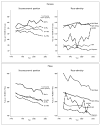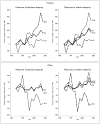An overview of methods for monitoring social disparities in cancer with an example using trends in lung cancer incidence by area-socioeconomic position and race-ethnicity, 1992-2004
- PMID: 18344513
- PMCID: PMC2409988
- DOI: 10.1093/aje/kwn016
An overview of methods for monitoring social disparities in cancer with an example using trends in lung cancer incidence by area-socioeconomic position and race-ethnicity, 1992-2004
Abstract
The authors provide an overview of methods for summarizing social disparities in health using the example of lung cancer. They apply four measures of relative disparity and three measures of absolute disparity to trends in US lung cancer incidence by area-socioeconomic position and race-ethnicity from 1992 to 2004. Among females, measures of absolute and relative disparity suggested that area-socioeconomic and race-ethnic disparities increased over these 12 years but differed widely with respect to the magnitude of the change. Among males, the authors found substantial disagreement among summary measures of relative disparity with respect to the magnitude and the direction of change in disparities. Among area-socioeconomic groups, the index of disparity increased by 47% and the relative concentration index decreased by 116%, while for race-ethnicity the index of disparity increased by 36% and the Theil index increased by 13%. The choice of a summary measure of disparity may affect the interpretation of changes in health disparities. Important issues to consider are the reference point from which differences are measured, whether to measure disparity on the absolute or relative scale, and whether to weight disparity measures by population size. A suite of indicators is needed to provide a clear picture of health disparity change.
Conflict of interest statement
Conflict of interest: none declared.
Figures



Comment in
-
Invited commentary: measuring social disparities in health--what was the question again?Am J Epidemiol. 2008 Apr 15;167(8):900-4; author reply 908-16. doi: 10.1093/aje/kwn019. Epub 2008 Mar 15. Am J Epidemiol. 2008. PMID: 18344512
-
Re: "An overview of methods for monitoring social disparities in cancer with an example using trends in lung cancer incidence by area-socioeconomic position and race-ethnicity, 1992-2004".Am J Epidemiol. 2008 Nov 15;168(10):1214-6; author reply 1216. doi: 10.1093/aje/kwn317. Epub 2008 Oct 15. Am J Epidemiol. 2008. PMID: 18922996 No abstract available.
References
-
- US Department of Health and Human Services. Healthy People 2010: understanding and improving health. Washington, DC: US Government Printing Office; 2000.
-
- Keppel KG, Pearcy JN, Klein RJ. Measuring progress in Healthy People 2010. Hyattsville, MD: National Center for Health Statistics; 2004. (DHHS publication no. (PHS) 2004-1237) - PubMed
-
- Harper S, Lynch J. Methods for measuring cancer disparities: a review using data relevant to Healthy People 2010 cancer-related objectives. Washington, DC: National Cancer Institute; 2006. ( http://seer.cancer.gov/publications/disparities/)
-
- Keppel K, Pamuk E, Lynch J, et al. Methodological issues in measuring health disparities. Hyattsville, MD: National Center for Health Statistics; 2005. (Vital and health statistics, series 2: data evaluation and methods research, no. 141). ( http://www.cdc.gov/nchs/data/series/sr_02/sr02_141.pdf) - PMC - PubMed
Publication types
MeSH terms
Grants and funding
LinkOut - more resources
Full Text Sources
Medical

